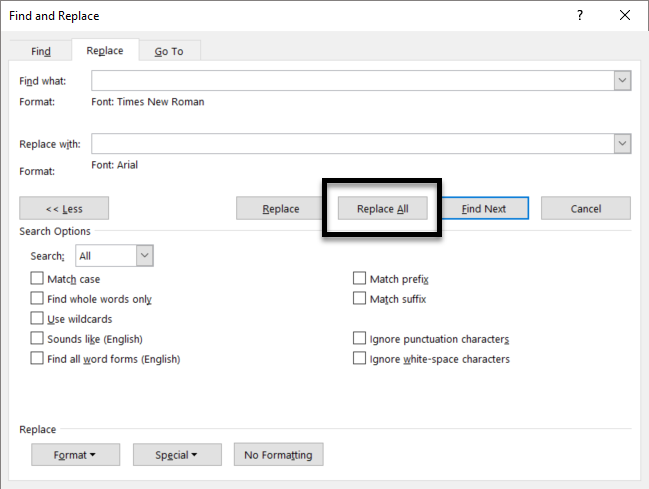
- MICROSOFT WORD FIND AND REPLACE FONT SIZE HOW TO
- MICROSOFT WORD FIND AND REPLACE FONT SIZE MANUAL
- MICROSOFT WORD FIND AND REPLACE FONT SIZE MAC
- MICROSOFT WORD FIND AND REPLACE FONT SIZE WINDOWS
MICROSOFT WORD FIND AND REPLACE FONT SIZE MANUAL
However, there are times when Find and Replace can help you save time by applying formatting changes faster and easier than manual formatting. If you need to control what gets changed and what doesn’t more precisely, you might be better off going through your document and making those changes by hand. For example, if you need to change the color of all text or remove all instances of bold text in your document, you can do this by selecting all (Ctrl+A) and then applying the change you want. Sometimes, it makes sense to apply formatting changes manually. There are many ways to use Find and Replace for formatting, but when should you consider using Find and Replace instead of applying manual formatting changes or using other options like the Format Painter? When Is Finding and Replacing Formatting Useful? You can also use Find and Replace to locate specific types of formatting throughout your document and even replace that formatting with something else. Only once you are confident it works, then click Replace All otherwise, keep clicking Find Next and replacing individually.Microsoft Word’s Find and Replace feature isn’t just for replacing text. Click Find Next, then Replace for the first few.ġ7. You should now have NOTHING in either field, but text underneath each-under the both fields, you should have Font: x pt, Superscript.ġ6. In the Size column, select the font size used for the main text (e.g. Put your cursor in the Replace field, then click the Format button.ġ2. In the Size column, select the font size used for the superscripts (e.g. Put your cursor in the Find field, then click the Format button.ħ. Click More to open the extra options on that dialog box.ĥ.
MICROSOFT WORD FIND AND REPLACE FONT SIZE WINDOWS
Open the Find and Replace dialog box (Ctrl+H for Word for Windows - not sure what it is for Mac).Ĥ. For the rest of these steps I assume 8 pt superscript and 11 pt body text.ģ. 8 pt) AND the size of the normal characters (e.g. Identify what the superscript font size is (e.g. Check if the superscripts are the same font size (I assume they are if the data was exported from somewhere else).Ģ.
MICROSOFT WORD FIND AND REPLACE FONT SIZE MAC
The steps below are for Word for Windows, but you should be able to do the same in Mac (the commands may be a little different).ġ.

You’re a hero and you’ve just saved yourself a heap of editing time! In the Replace with field, type ^c (that’s a Shift+6 for the caret character and a lower case ‘ c‘ - the ‘c’ MUST be lower case).

MICROSOFT WORD FIND AND REPLACE FONT SIZE HOW TO
Perhaps the author didn’t know how to create a subscript ( Ctrl+=) or superscript ( Ctrl+Shift+=) easily, or they thought it didn’t matter, or perhaps they thought the editor would sort it out.

Here’s a trick that’s been around since at least Word 6.0! It works in Word 2003, 20, even though this Microsoft Support article might make you think that it only works up to Word 97.ĭid you know that you can do a find for something like H2O and replace it with H 2O? Let’s assume you are writing or editing a scientific document and there are many instances of H2O, CO2, H2SO4, m3 (cubic metres) etc.


 0 kommentar(er)
0 kommentar(er)
